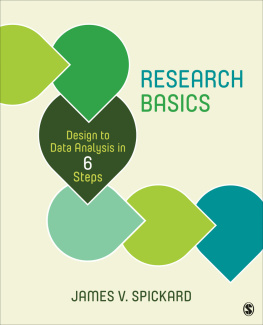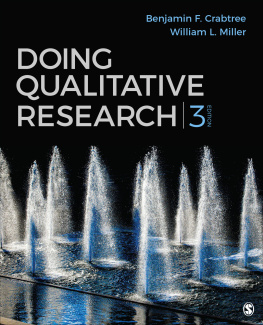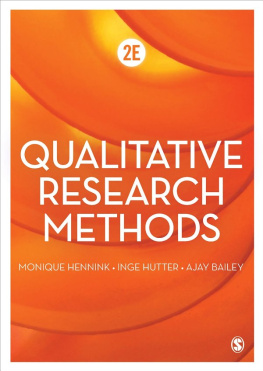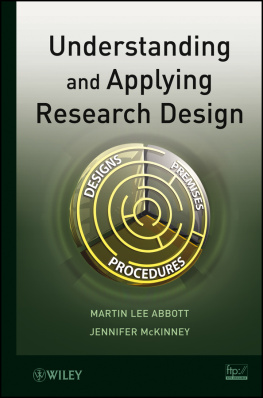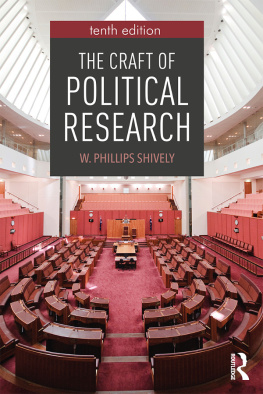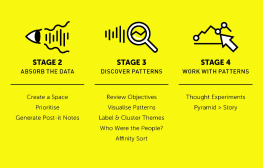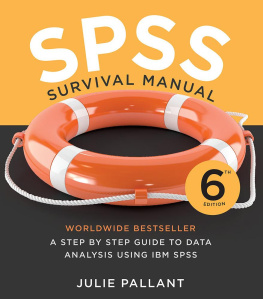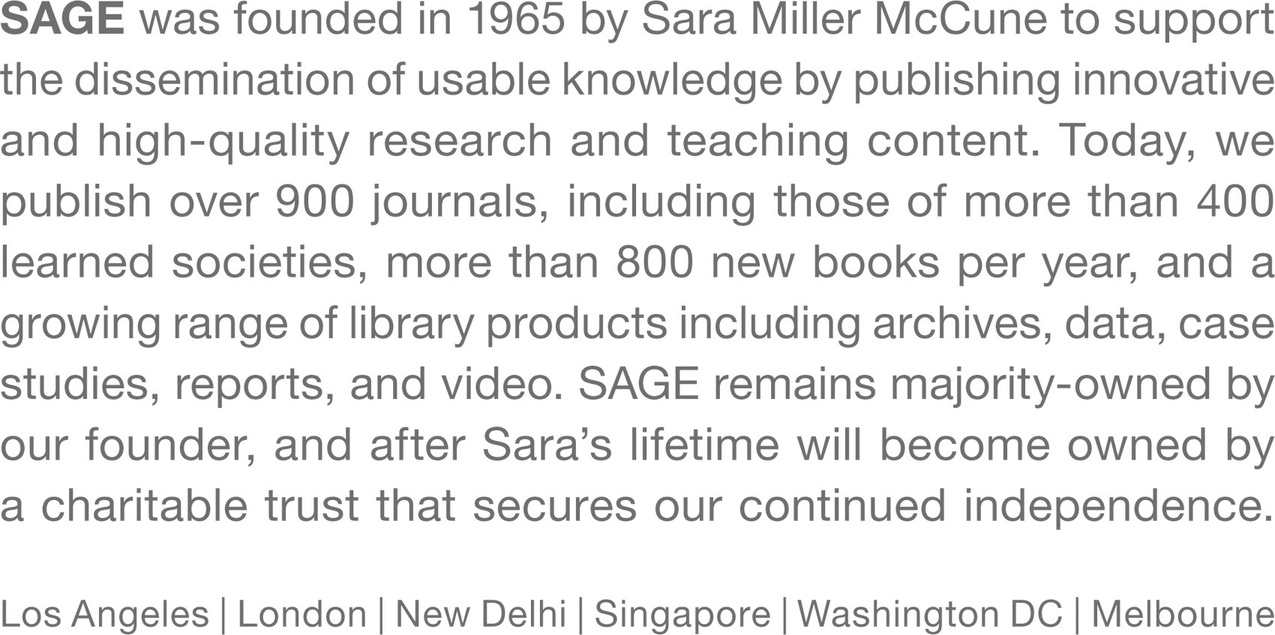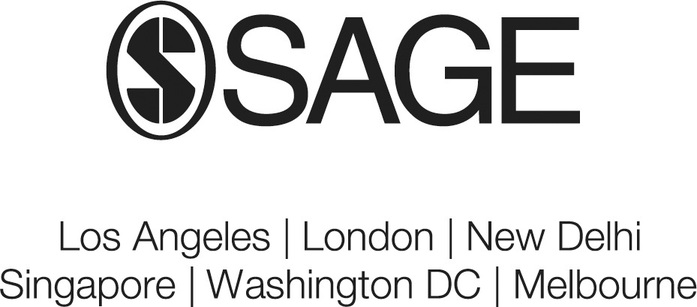Research Basics
Overview
This book offers a six-step system for designing social science research. You start by developing a good research question on the topic that you wish to investigate. You then choose a logical structure that will lead you to an answer. Together, the question and the logical structure identify the type of data you need to produce that answer. Once you know what type of data you need, you can pick the best data collection method for gathering it, the data collection site where you are apt to find it, and the best data analysis method to use. Do the six steps, and youve designed your research. Then all you have to do is carry it out.
The cover picture shows this relationship graphically. The book describes each step in detail, with examples.
Research Basics
Design to Data Analysis in Six Steps
- James V. Spickard
- University of Redlands
FOR INFORMATION:
SAGE Publications, Inc.
2455 Teller Road
Thousand Oaks, California 91320
E-mail: order@sagepub.com
SAGE Publications Ltd.
1 Olivers Yard
55 City Road
London EC1Y 1SP
United Kingdom
SAGE Publications India Pvt. Ltd.
B 1/I 1 Mohan Cooperative Industrial Area
Mathura Road, New Delhi 110 044
India
SAGE Publications Asia-Pacific Pte. Ltd.
3 Church Street
#10-04 Samsung Hub
Singapore 049483
Copyright 2017 by SAGE Publications, Inc.
All rights reserved. No part of this book may be reproduced or utilized in any form or by any means, electronic or mechanical, including photocopying, recording, or by any information storage and retrieval system, without permission in writing from the publisher.
Printed in the United States of America
Library of Congress Cataloging-in-Publication Data
Names: Spickard, James V., author.
Title: Research basics : design to data analysis in six steps / James V. Spickard, University of Redlands.
Description: Los Angeles : SAGE, [2017] | Includes bibliographical references and index.
Identifiers: LCCN 2016026731 | ISBN 9781483387215 (pbk. : alk. paper)
Subjects: LCSH: Social sciencesResearchMethodology. |ResearchMethodology.
Classification: LCC H62 .S72984 2017 | DDC 001.4/2dc23 LC record available at https://lccn.loc.gov/2016026731
This book is printed on acid-free paper.
Acquisitions Editor: Leah Fargotstein
Development Editor: Eve Oettinger
Editorial Assistant: Yvonne McDuffee
eLearning Editor: Laura Kirkhuff
Production Editor: Kelly DeRosa
Copy Editor: Amy Marks
Typesetter: C&M Digitals (P) Ltd.
Proofreader: Scott Oney
Indexer: Sheila Bodell
Cover Designer: Rose Storey
Marketing Manager: Susannah Goldes
Brief Contents
- or send a letter to Creative Commons, PO Box 1866, Mountain View, CA 94042.
List of Figures and Tables
Figures
- 32
- 33
- 39
- 50
- 50
- 103
- 108
- 122
- 123
- 125
- 131
- 132
- 132
- 133
- 134
- 145
- 161
- 163
- 164
- 164
- 165
- 167
- 167
- 203
- 210
- 218
- 222
- 223
- 223
- 225
- 237
- 244
- 246
- 247
- 250
- 253
- 254
- 256
- 257
- 257
- 258
- 258
- 259
- 260
- 273
- 286
- 292
- 330
- 338
Tables
- 49
- 65
- 69
- 104
- 124
- 127
- 128
- 130
- 137
- 141
- 158
- 160
- 171
- 174
- 176
- 177
- 180
- 191
- 192
- 194
- 198
- 200
- 202
- 204
- 206
- 207
- 228
- 251
- 259
- 333
- 337
- 339
- 345
- 347
For Instructors: Why This Book?
There are lots of books about research, but none quite like this one. Thirty years of teaching social science research has convinced me that the standard approaches need revision. Theyre not wrong, if you already know what youre doing. Yet most students dont. Even graduate students make simple errors, because their textbooks dont show them how to think through the research process clearly.
Three problems with most research textbooks get in the way of student learning.
First, most texts are titled something like Research Methods. They focus on various data gathering techniques: from survey research to questionnaire construction to detached and participant observation to content analysis, and so on. Such data gathering methods are important, but that isnt where research must start.
Instead, research starts with developing a good research question and a logical structure for what it takes to produce an answer. The question identifies exactly what you are looking for. The logical structure describes exactly what you have to do to find it. Students often dont know how to create clear research questions and they frequently neglect to think through their research logic. They need to be taught how to do both. Research Basics starts with these two steps. It teaches readers how to craft a research question and how to identify a logical process for answering it. Thats where research begins, so it is the first focus of this book.
Second, even those texts that provide a pro forma chapter on the research question typically jump directly from that chapter to a series of chapters on various data gathering techniques. This leaves out a crucial intermediate step. Before you can choose a research method, you have to identify the type of data that you need to answer the question you have posed. In my experience, most students dont know how to do this, and most textbooks dont cover it very clearly.
For example, Ive seen even top-notch graduate students think that they can get a deep understanding of peoples worldviews with a mailed questionnaire. This is not an appropriate data collection method for getting at deep understandings. Surveys are fine for eliciting shallow opinions, but they are inadequate for tapping deep, nuanced ways of thinking. Standard textbooks have chapters on how to gather both types of data, but they usually dont teach students how to identify the type of data their particular research question needs. Research Basics does. It draws a clear connection between the type of data one needs and the best ways to gather it. This helps research succeed.
Research Basics also highlights how to choose a data collection sitewhere you think youll be able to find the data you need.
This brings us to the third problem with standard textbooks: They typically divide data collection methods into two categories: quantitative and qualitative. This approach reflects a misunderstanding of what methods do. Whether a study is quantitative or qualitative depends on how one analyzes the data, not on the method one uses to collect it. If you intend to count your data, the study is quantitative. If you dont, your study is qualitative. Most data collection methods can be used with either quantitative or qualitative research.

